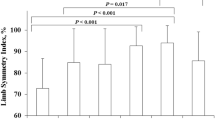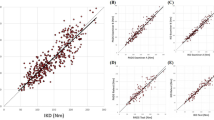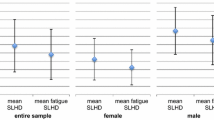Abstract
Purpose
Single-legged hop tests and isokinetic muscle torque are common outcome measures in the evaluation of knee function. The reliability of the single-legged hop tests in children has not been documented. The aim was to examine inter- and intrarater reliability of four single-legged hop tests and isokinetic muscle torque measurements in children.
Methods
Twenty-eight sports-active children (12.4 ± 0.3 years old) were tested three times in two test sessions separated by 1 week. They performed four single-legged hop tests and concentric isokinetic torque measurements during knee extension and flexion. Inter- and intrarater reliability were calculated using the intraclass correlation coefficient (ICC 2,1). Relative terms of the standard error of measurement (SEM %) and smallest real difference (SRD %) were emphasized to allow comparison between the different variables.
Results
Twenty-six children were included for statistical analysis. ICCs for inter- and intrarater reliability were moderate to high for the hop tests (0.62–0.91) and isokinetic measurements (0.76–0.87). SEMs % were low for the hop tests (3.9–7.4 %) and the isokinetic measurements (5.2–8.9 %). SRDs % were 20.5 % or less for the hop tests, 15.7 % or less for knee extension, and 24.6 % or less for knee flexion.
Conclusion
The single-legged hop tests and isokinetic muscle torque measurements demonstrated moderate-to-high reliability with low measurement error in sports-active children. A change above 20.5 % for the single-legged hop tests, 15.7 % for knee extension, and 24.6 % for knee flexion is necessary to represent a real change in knee function.
Level of evidence
III.

Similar content being viewed by others
References
Ayalon M, Ben-Sira D, Hutzler Y, Gilad T (2000) Reliability of isokinetic strength measurements of the knee in children with cerebral palsy. Dev Med Child Neurol 42(6):398–402
Bahr R, Holme I (2003) Risk factors for sports injuries—a methodological approach. Br J Sports Med 37(5):384–392
Baumgartner TA (2003) Measurement for evaluation in physical education and exercise science. McGraw-Hill, Boston
Bent NP (2009) Selecting outcome measures in sports medicine: a guide for practitioners using the example of anterior cruciate ligament rehabilitation. Br J Sports Med 43(13):1006–1012
Caine D, Maffulli N, Caine C (2008) Epidemiology of injury in child and adolescent sports: injury rates, risk factors, and prevention. Clin Sports Med 27(1):19–50 vii
de Vet HC, Terwee CB, Ostelo RW, Beckerman H, Knol DL, Bouter LM (2006) Minimal changes in health status questionnaires: distinction between minimally detectable change and minimally important change. Health Qual Life Outcomes 4:54
Deighan MA, De Ste Croix MBA, Armstrong N (2003) Reliability of isokinetic concentric and eccentric knee and elbow extension and flexion in 9/10 year old boys. Isokinet Exerc Sci 11(2):109–115
Eitzen I, Hakestad KA, Risberg MA (2012) Inter- and intrarater reliability of isokinetic thigh muscle strength tests in postmenopausal women with osteopenia. Arch Phys Med Rehabil 93(3):420–427
Eitzen I, Moksnes H, Snyder-Mackler L, Engebretsen L, Risberg MA (2010) Functional tests should be accentuated more in the decision for ACL reconstruction. Knee Surg Sports Traumatol Arthrosc 18(11):1517–1525
Hartmann A, Knols R, Murer K, De Bruin ED (2009) Reproducibility of an isokinetic strength-testing protocol of the knee and ankle in older adults. Gerontology 55(3):259–268
Holm I, Fredriksen P, Fosdahl M, Vollestad N (2008) A normative sample of isotonic and isokinetic muscle strength measurements in children 7–12 years of age. Acta Paediatr 97(5):602–607
Hopkins WG (2000) Measures of reliability in sports medicine and science. Sports Med 30(1):1–15
Janarv PM, Nystrom A, Werner S, Hirsch G (1996) Anterior cruciate ligament injuries in skeletally immature patients. J Pediatr Orthop 16(5):673–677
Kellis E, Kellis S, Gerodimos V, Manou V (1999) Reliability of isokinetic concentric and eccentric strength in circumpubertal soccer players. /Fiabilite des mesures de la force isocinetique concentrique et excentrique chez des joueurs de football autour de la puberte. Pediatr Exerc Sci 11(3):218–228
Lexell JE, Downham DY (2005) How to assess the reliability of measurements in rehabilitation. Am J Phys Med Rehabil 84(9):719–723
Merlini L, Dell’Accio D, Granata C (1995) Reliability of dynamic strength knee muscle testing in children. J Orthop Sports Phys Ther 22(2):73–76
Mohtadi N, Grant J (2006) Managing anterior cruciate ligament deficiency in the skeletally immature individual: a systematic review of the literature. Clin J Sport Med 16(6):457–464
Mohtadi NG, Kiefer GN, Tedford K, Watters S (1990) Concentric and eccentric quadriceps torque in pre-adolescent males. Can J Sport Sci 15(4):240–243
Moksnes H, Engebretsen L, Eitzen I, Risberg MA (2013) Functional outcomes following a non-operative treatment algorithm for anterior cruciate ligament injuries in skeletally immature children 12 years and younger. A prospective cohort with 2 years follow-up. Br J Sports Med 47(8):488–494
Moksnes H, Engebretsen L, Risberg MA (2012) Management of anterior cruciate ligament injuries in skeletally immature individuals. J Orthop Sports Phys Ther 42(3):172–183
Munro AG, Herrington LC (2011) Between-session reliability of four hop tests and the agility t test. J Strength Cond Res 25(5):1470–1477
Noyes FR, Barber SD, Mangine RE (1991) Abnormal lower limb symmetry determined by function hop tests after anterior cruciate ligament rupture. Am J Sports Med 19(5):513–518
Parkkari J, Pasanen K, Mattila VM, Kannus P, Rimpela A (2008) The risk for a cruciate ligament injury of the knee in adolescents and young adults: a population-based cohort study of 46,500 people with a 9 year follow-up. Br J Sports Med 42(6):422–426
Portney LG, Watkins MP (2000) Foundations of clinical research: applications to practice. Prentice Hall, Upper Saddle River
Reid A, Birmingham TB, Stratford PW, Alcock GK, Giffin JR (2007) Hop testing provides a reliable and valid outcome measure during rehabilitation after anterior cruciate ligament reconstruction. Phys Ther 87(3):337–349
Ross MD, Irrgang JJ, Denegar CR, McCloy CM, Unangst ET (2002) The relationship between participation restrictions and selected clinical measures following anterior cruciate ligament reconstruction. Knee Surg Sports Traumatol Arthrosc 10(1):10–19
Ross MD, Langford B, Whelan PJ (2002) Test-retest reliability of 4 single-leg horizontal hop tests. J Strength Cond Res 16(4):617–622
Santos AN, Pavao SL, Avila MA, Salvini TF, Rocha NA (2013) Reliability of isokinetic evaluation in passive mode for knee flexors and extensors in healthy children. Braz J Phys Ther 17(2):112–120
Shrout PE, Fleiss JL (1979) Intraclass correlations: uses in assessing rater reliability. Psychol Bull 86(2):420–428
Sole G, Hamren J, Milosavljevic S, Nicholson H, Sullivan SJ (2007) Test–retest reliability of isokinetic knee extension and flexion. Arch Phys Med Rehabil 88(5):626–631
Streiner DL, Norman GR (2008) Reliability. In: Streiner DL, Norman GR (eds) Health measurement scales: a practical guide to their development and use, 4th edn. Oxford University Press, Oxford, pp 167–210
Tsiros MD, Grimshaw PN, Schield AJ, Buckley JD (2011) Test–retest reliability of the biodex system 4 isokinetic dynamometer for knee strength assessment in paediatric populations. J Allied Health 40(3):115–119
Turner D, Schunemann HJ, Griffith LE, Beaton DE, Griffiths AM, Critch JN, Guyatt GH (2010) The minimal detectable change cannot reliably replace the minimal important difference. J Clin Epidemiol 63(1):28–36
Walter SD, Eliasziw M, Donner A (1998) Sample size and optimal designs for reliability studies. Stat Med 17(1):101–110
Weir JP (2005) Quantifying test–retest reliability using the intraclass correlation coefficient and the SEM. J Strength Cond Res 19(1):231–240
Acknowledgments
We would like to thank Kristin Bølstad for help with the preparation of the study. Maren Hjelle Guddal, Arnhild Bakken, Nina Markussen, and Carina Wold are acknowledged for their assistance on the test days. Thanks to Professor Ingar Holme, at the Norwegian School of Sport Sciences, for helpful advice on the statistical analysis. Additionally, the Norwegian Sports Medicine Clinic (NIMI) is acknowledged for the contribution of infrastructure.
Conflict of interest
The authors declare that there are no conflict of interests.
Author information
Authors and Affiliations
Corresponding author
Appendix: Reliability of all the selected isokinetic muscle torque measurements
Rights and permissions
About this article
Cite this article
Johnsen, M.B., Eitzen, I., Moksnes, H. et al. Inter- and intrarater reliability of four single-legged hop tests and isokinetic muscle torque measurements in children. Knee Surg Sports Traumatol Arthrosc 23, 1907–1916 (2015). https://doi.org/10.1007/s00167-013-2771-x
Received:
Accepted:
Published:
Issue Date:
DOI: https://doi.org/10.1007/s00167-013-2771-x




